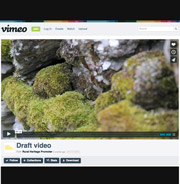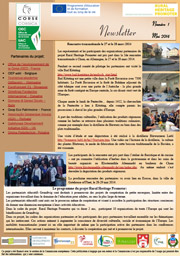Visit to Lama - Corsica
SITE VISIT / STUDY HERITAGE SITE - Friday, 24.01.2014 Lama
Lama is a commune of 174 inhabitants of the valley of Ostriconi located east of Balagne. The village of Lama is marked by the contrast between the rich mansions Tuscan influence and the medieval atmosphere of the old center . This contrast brings an undeniable asset wealth to the territory. The village of Lama presents a panorama essentially mineral whose surroundings are a strong testimony of human organization on a difficult site because of the scarcity of water and land .
The activity of visit / study heritage site was organized by the Office for the Environment of Corsica in close collaboration with the Municipality of Lama , the Joint Union countries Balagne. The “The Ortu di Funtana Bona “ Association and the local population have been associated .
Participants were receptions by representatives of the municipality of Lama. François Massiani , Deputy Mayor , welcomed the Rural Heritage project partners Promoter and thanked the CAB have chosen as the study site Heritage Site Lama and outlines issues of territory and elements of the existing heritage. Indeed, this choice was determined by the rich and varied architectural heritage enjoyed by the community. This legacy of previous generations is real wealth and the common people should protect and enhance . Architectural feature of Lama is to see the harmonious marriage of two different styles : the old medieval quarter , consisting of small houses with flat roofs glued to each other , narrow alleys and vaulted , and an “architecture of affirmation” the wealthiest families growers who are building the eighteenth century, large mansions Tuscan-inspired the first houses were erected Lama on a kind of “ eagle’s nest “ at the foot of a tower watch called “ A Torra .” The town is divided into two main areas: the shady ( umbria ) is a series of rolling hills , very green , covered with a traditional Mediterranean maquis , with many olive trees near the river bed on a relatively flat area . The adret ( sulana ) rocky with jagged edges on the heights (up to Monte Astu -1535 m) , is dry, with little trees outside the vicinity of the village.
Then the floor was given to Tony Tony Ceccaldi Ceccaldi , President of the Syndicat Mixte Country Balagne and Pierre POLI Vice President, to present a diagnosis of the territory of Balagne with its issues and problems as well as the European leader program 2007 - in 2013 to build an economy of heritage Tourism in Balagne (different strategic directions , operational objectives, recommended actions and an initial assessment of the program ppt see attached presentation).
Following these interventions , the partners were able to borrow the heritage trail discovering the activities implemented by local actors in connection with the concept of “ heritage trail “ developed by the CAB.
Beveraggi Guy, president of the association “The Ortu di Funtana Bona “ and his assistant Jean- Paul Waechter shared with transnational partners its different “ ways “ to enhance the wealth of a country , ways of working together on a space . The main activities of the association are: Rehabilitation of old gardens and their stone walls , installation of endemic plants.
The Association “The Ortu di Funtana Bona “ conduits animation programs involving actors territory , local skills, people to boost local dynamics by allowing a wider audience to see , know, understand and take part in the enhancement of their heritage . For example , an animation action was organized at the end of 2013 in directione two classes of schoolchildren . (“ Urtaca and Belgodère on the Heritage Trail , walking, exploring the flora and surrounding nature “).
The Environment Agency of Corsica, leader of the Rural Heritage Project Promoter presented transnational partners in this study visit policy wealth management and implementation of the multiannual program for creating “ paths Heritage “. The “ heritage trails “ within the valuation of the vernacular heritage as offering for the general population and the tourist population in particular. This concept is fully shared between residents and tourists. In addition, it carries dynamic in terms of local development, the reacquisition of know-how and the creation of value within territorial entities that all seek to enroll in backup strategies , transmission and development of heritage tourism hitherto neglected. These walks browsing entities village and surrounding countryside must be rich elements of traditional heritage buildings building drystone traditional development channels of communication rural elements unprotected heritage (oven , fountains , laundries ... ) symbolic sites of historical facts , religious, secular as well as everything that conveys the spirit of the place and the art of living on a territory.
The Office of Environment Corsica mobilize funding for the work , signage and project management in the axis 3 of the EAFRD on heritage development across rural areas .
Representatives of the OEC also presented the work done in the framework of an ongoing project “Accessibility heritage “ ( Maritimo program):
Stairs with a soil treatment using traditional techniques have been achieved.
Many piecemeal changes give rise to the establishment of ricciade , restoration of dry stone walls and copings or the realization of stone drains .
Siding and other improvements have been implemented only on areas of the public domain.
An interpretation device consisting of a label interpretation was developed in a participatory manner , and installed the remarkable points of the trail.
The restoration and development of the edge of a fountain and a tank has been made.
Operations for accessibility to propose the discovery and understanding of the built and natural heritage located near the trail. ( virtual visits made from panoramic images taken by drones, interpretive panels
The underlying idea of these interventions is to restore the heritage place in the local community and empower local actors to initiate a development strategy , geared to the areas inside and on the markers identity .
The CSB pays close attention to projects with animations and training foster links with local populations
Appendix : Brief Overview of Heritage Trail Lama
The municipality of Lama is a rural community demographically sparsely populated with small and with limited resources makes economic activity, in contrast heritage to preserve and enhance rich . For years, the municipality intends to strengthen its efforts in preserving the environment, but also economic development through the enhancement of the built heritage and local know-how . Work in this direction was initiated several years now and the Heritage Trail is only an extension and a dynamic tool of development.
Objective of the Heritage Trail Lama : Replace the village in its immediate environment, ie through the trail inform the history of its establishment and development
It fits consistently in the project territory Lama , both by the work of reappropriation of the past that offers the residents of the town but also the possibility of development of tourism that armature. This trail does not merely give to see it interprets , it offers meaning. It makes sense .
Interest circuit
It is therefore more to see but to understand through the presence of water the different stages of development of the village until contemporary times.
circuit:
Check the “ Stallo “ ( photographic exhibition room of the old life in the village)
Fontaine canale di u , instead of traditional water
Monte Grosso , the Tarpeian rock dogs ( panoramic view of the valley)
The funeral chapel Saturnini
Gardens cluster : all grown very small size plots nearby brook Macinajo
Terraced gardens : organization of plots for water management
Fontana Bona wash fountain
Sheep and wheat area
Mulch and tank
Fontaine Franzini
Cheese caves
Perspective use and dissemination :
- Establishment of advocacy and communication around the concept of “ heritage trails “ with all the actors likely to use “ Heritage Trails “ organization of guided visits to the trail as , home school organization of information days and an awareness of communication editing documents , creation of interactive tools.
- Creation and development of a regional network
http://ruralheritagepromoter.org/index.php/en/the-visits/corsica/9-visit-to-lama-corsica#sigProGalleria3beb1e5b6c






